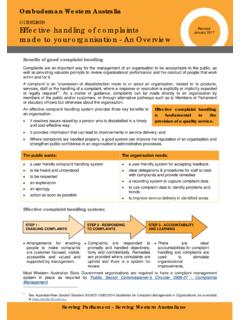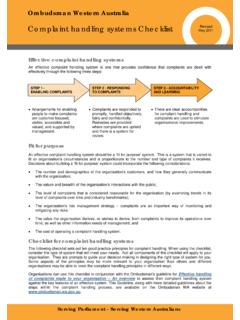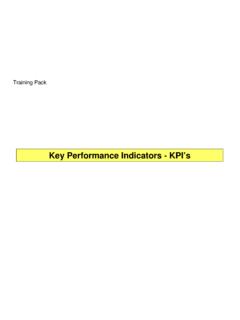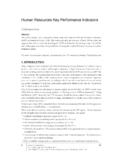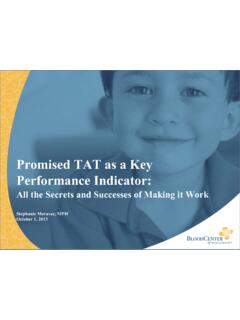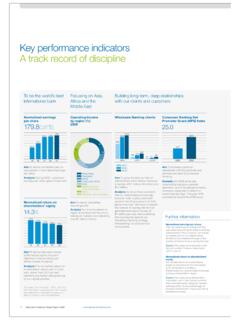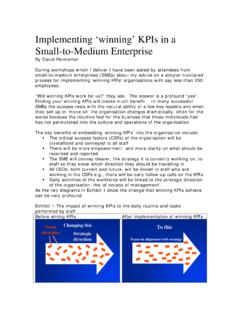Transcription of Using Key Performance Indicators to improve outcomes and ...
1 Ombudsman Western Australia Serving Parliament Serving Western Australians Mary White, Western Australian Deputy Ombudsman Presentation to the 4th Biennial ANZOA Conference 1 May 2014 How Ombudsman offices are bringing key Performance Indicators to life Using Key Performance Indicators to improve outcomes and services Outline of presentation Purpose Why have Key Performance Indicators (KPIs) Our Performance Management Framework Our Key Performance Indicators Internal early warning Indicators Monitoring Key Performance Indicators Achieving KPIs and continuous improvement Some words of caution Purpose of the presentation This presentation provides an overview of how the Western Australian Ombudsman uses key Performance Indicators (KPIs) to improve outcomes and service delivery and the results achieved through setting and monitoring KPIs.
2 Why have key Performance Indicators Legislative Framework in Western Australia (TI 904) Performance information, including KPIs: Assist stakeholders and interested parties such as government, Parliament and the community to assess: Agency Performance in achieving desired outcomes ; and Obtaining value for public funds from services delivered. Assist agencies to understand their own Performance by: Facilitating strategic planning; Enhancing resource management; and Highlighting areas for improvement. Why have key Performance Indicators Legislative Framework in Western Australia (cont) KPIs must be approved by the Under Treasurer and must: Be relevant, appropriate and fairly represent indicated Performance ; Provide a substantial overview of the operations and material expenses of the agency; and Be submitted to, and audited by, the Auditor General and be clearly identified in the annual report as the audited KPIs.
3 KPIs must be reported against set targets in Budget Papers and Annual Reports enabling stakeholders, in particular Parliament, to assess agency Performance against outcomes and service delivery. Why have key Performance Indicators Key benefits of KPIs for our Office Our experience is that meaningful KPIs enable us to: Report to Parliament on our Performance . Maintain a focus on our key strategic direction. Enable benchmarking over time and with like agencies. Monitor trends and determine the impact of, and adjust for, factors such as increased complaints or new functions.
4 Provide consistent external reporting of audited Indicators . Continuously improve processes to achieve results. Give staff direction and a sense of achievement. Why have key Performance Indicators Internal early warning Indicators KPIs for external reporting are, by their nature, high level and focused on agency level outcomes . This means: What gets measured, gets done is a benefit but may have the unintended consequence of insufficient focus on other important Performance areas; and High level KPIs show end of line results and may not allow for early intervention to correct emerging problems for service delivery.
5 Internal early warning Indicators enable us to monitor a wider range of important Performance areas and to give early warning of potential problems in meeting KPI targets. Our Performance Management Framework Key Effectiveness Indicators The percentage of recommendations accepted by public authorities. The number of improvements to practices or procedures as a result of Ombudsman action. Key Efficiency Indicators Percentage of allegations finalised within 3 months. Percentage of allegations finalised within 12 months. Percentage of allegations on hand at 30 June less than 3 months old.
6 Percentage of allegations on hand at 30 June less than 12 months old. Average cost per finalised allegation. Average cost per finalised death review notification. Service Provided by the Ombudsman s Office Resolving complaints about the decision making of public authorities and improving the standard of public administration. Desired outcomes of the Ombudsman s Office The public sector of Western Australia is accountable for, and is improving the standard of, administrative decision making, practices and conduct. Western Australian Ombudsman Performance Management Framework Our Key Performance Indicators KPIs need to cover a broad range of functions and to be high level.
7 Budget targets and actual results are reported in: Our Budget Papers. Our Annual Report which must include KPIs as set out in the Budget Papers (and audited by the Auditor General), and may include other Indicators . Our Key Performance Indicators Annual Report 2012-13 Key Effectiveness Indicators 2008-09 2009-10 2010-11 2011-12 2012-13 Target 2012-13 Actual Of allegations where the Ombudsman made recommendations to improve practices or procedures, percentage of recommendations accepted by agencies 100% 100% 100% 100% 100% 100% Number of improvements to practices or procedures as a result of Ombudsman action 29 49 57 96 100 72 2012-13 Annual Report - Key effectiveness Indicators Our Key Performance Indicators Annual Report 2012-13 Narrative on key effectiveness Indicators included.
8 In 2007-08, the Office commenced a program to ensure that its work increasingly contributed to improvements to public The number of as a result of Ombudsman action, has risen significantly since the commencement of the program but there may be fluctuations from year to year. For the fifth consecutive year, public authorities have accepted every recommendation made by the Ombudsman. The Annual Report also referred to the important role of the Ombudsman to enable remedies to be provided and that there were 139 actions to provide a remedy in 2012-13.
9 Our Key Performance Indicators Annual Report 2012-13 Key Efficiency Indicators 2008-09 2009-10 2010-11 2011-12 2012-13 Target 2012-13 Actual Percentage of allegations finalised within three months 82% 82% 78% 72% 85% 83% Percentage of allegations finalised within 12 months 96% 99% 96% 99% 99% 99% Percentage of allegations on hand at 30 June less than three months old 71% 63% 68% 45% 70% 94% Percentage of allegations on hand at 30 June less than 12 months old 96% 97% 98% 99% 99% 96% 2012-13 Annual Report - Key efficiency Indicators Our Key Performance Indicators Annual Report 2012-13 Narrative on timeliness included reference to improvements over the last year including: Allegations finalised within 3 months improved from 72% to 83%; Allegations on hand less than 3 months old at 30 June significantly improved from 45% to 94%; There has been a reduction from 53 days to 46 days (13%) in the average time to finalise complaints; There has been a reduction from 99 days to 33 days (67%) in the average age of complaints on hand at 30 June.
10 And The Office has maintained its low level of aged cases with 99% of allegations finalised within 12 months and 96% of allegations on hand less than 12 months old at 30 June. Our Key Performance Indicators Annual Report 2012-13 Key Efficiency Indicators 2008-09 2009-10 2010-11 2011-12 2012-13 Target 2012-13 Actual Average cost per finalised allegation (net cost of complaint resolution services divided by the number of allegations finalised) $2,759 $1,999 $1,899 $1,866 $1,875 $1,821 Average cost per finalised notification of death (net cost of undertaking the function to review certain child deaths and family and domestic violence fatalities divided by the number of notifications finalised) NA $9,377 $9,651 $10,410 $9,600 $12,281 2012-13 Annual Report - Key efficiency Indicators (cont) Our Key Performance Indicators Annual Report 2012-13 Narrative on key efficiency Indicators relating to costs included.
